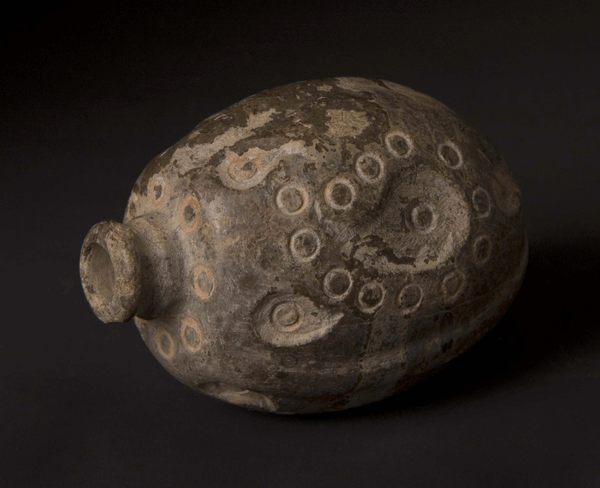Sphero-Conical Stone Vessel, 9th Century CE - 12th Century CE
Stoneware
3.75
LO.675
Spherical grey stone vessel with a narrow neck with small everted rolled rim and pointed on its lower part.The upper part is decorated with a dotted circles, which also cover...
Spherical grey stone vessel with a narrow neck with small everted rolled rim and pointed on its lower part.The upper part is decorated with a dotted circles, which also cover the body at regular intervals and cluster where the body features a circular depression.
Dotted circles were a trademark of Khurasan and Central Asia, or what is now known as western Afghanistan, during the ninth to the eleven centuries. They were frequently used on metalwork, pottery and wood carving.
Various interpretations have been offered regarding the actual function of such vessels, from grenades, fire-blowers (aeolipiles), to containers of precious liquids or plumb bobs. Indeed recently the Conservation Department of the Institute of Archaeology, University of London, while analysing one sphero-conical vessel, found traces of mercury, thus indicating that some of these objects could have been used to contain mercury. Other authors, relying on epigraphic evidence, have suggested that some of them would have stored beer. What seems logic is that sphero-conical vessels, depending on the shape and material, would have then served different purposes. Not only were they eclectic in function, they also have been found in sites throughout the Middle East up to Central Asia, datable from the 9th century up to the Mongol invasion (13th century), attesting to their incredible success as portable carriers of precious substances.
For comparable examples see:
G. Fehervari, Ceramic of the Islamic World in the Tarek Rajab Museum, 2000: pp 207-231.
Richard Ettinghausen, 'The Use of sphero-Conical Vessels in the Muslim East', Journal of Near Eastern Studies, XXIV, 1965: 218-229. Sphero-conical vessel, grayish stoneware with carved decoration; egg-shaped body, with a short neck and rolled rim. The body is decorated with carved rings.
Iran or Central Asia, 9th – 12th century.
Prof. Geza Fehervar Prof. Geoffrey Kin
Dotted circles were a trademark of Khurasan and Central Asia, or what is now known as western Afghanistan, during the ninth to the eleven centuries. They were frequently used on metalwork, pottery and wood carving.
Various interpretations have been offered regarding the actual function of such vessels, from grenades, fire-blowers (aeolipiles), to containers of precious liquids or plumb bobs. Indeed recently the Conservation Department of the Institute of Archaeology, University of London, while analysing one sphero-conical vessel, found traces of mercury, thus indicating that some of these objects could have been used to contain mercury. Other authors, relying on epigraphic evidence, have suggested that some of them would have stored beer. What seems logic is that sphero-conical vessels, depending on the shape and material, would have then served different purposes. Not only were they eclectic in function, they also have been found in sites throughout the Middle East up to Central Asia, datable from the 9th century up to the Mongol invasion (13th century), attesting to their incredible success as portable carriers of precious substances.
For comparable examples see:
G. Fehervari, Ceramic of the Islamic World in the Tarek Rajab Museum, 2000: pp 207-231.
Richard Ettinghausen, 'The Use of sphero-Conical Vessels in the Muslim East', Journal of Near Eastern Studies, XXIV, 1965: 218-229. Sphero-conical vessel, grayish stoneware with carved decoration; egg-shaped body, with a short neck and rolled rim. The body is decorated with carved rings.
Iran or Central Asia, 9th – 12th century.
Prof. Geza Fehervar Prof. Geoffrey Kin



